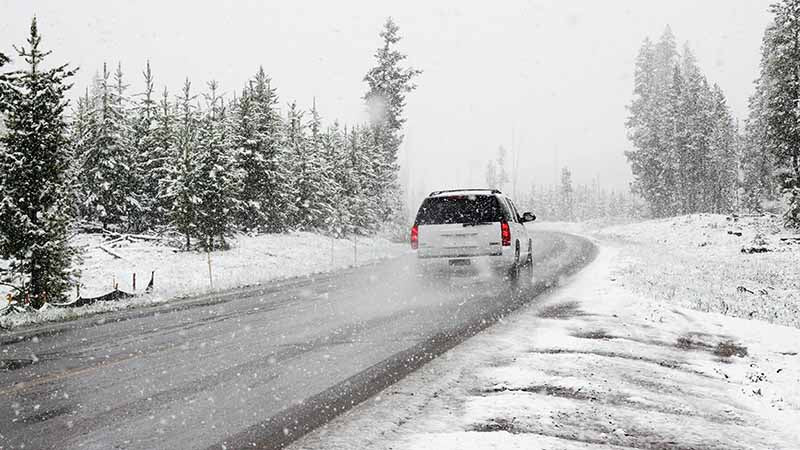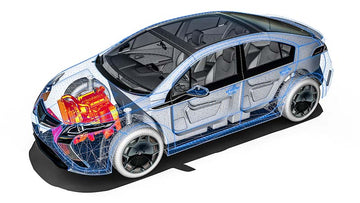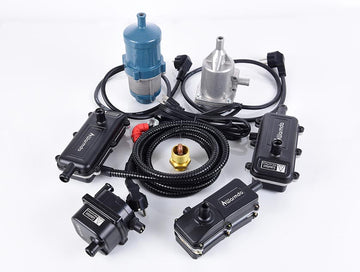How does an engine block heater work?
Aug 13, 2020
Why You Should Use an Engine Block Heater
Fuel Dynamics and Efficiency
The primary reason to use an engine block heater stems directly from the fundamental properties of fuel, applicable to all engine types—whether diesel, gasoline, or natural gas. In cold weather, the lubricants inside the engine thicken and nearly solidify. This increased viscosity hampers the starter’s ability to effectively move the piston and crankshaft, often resulting in the vehicle's failure to start.

Metal Contraction in Cold Weather
Engines, regardless of fuel type, are primarily made of metal, which naturally contracts in cold temperatures. The degree of contraction depends on the engine's size and the amount of metal used—a critical factor in engine design.
When an engine starts, it expands due to the heat generated internally, a standard aspect of its function. However, managing the variable contraction of different metals, each with unique thermal properties, can be challenging.

In cold conditions, this contraction can significantly change the spacing between engine components, potentially compromising the integrity of the engine block's seal. This may lead to incomplete combustion, resulting in higher emissions of pollutants—a significant environmental concern.
Furthermore, colder oil moves more sluggishly, failing to lubricate critical engine parts like the crankshaft and cylinders quickly enough. This can accelerate wear and tear, leading to expensive repairs. Using an engine block for heater helps mitigate these problems by ensuring a smoother, more eco-friendly start.
How Do Engine Block Heaters Help?
Boosting Engine Performance with Engine Block Heaters
Engine block heaters play an essential yet simple role: they pre-heat your engine to optimal temperatures before you start it. By using a block heater, you can raise the engine’s temperature to about 15-20 degrees Celsius (59-68 degrees Fahrenheit). This adjustment makes starting your engine in the chilly winter months as easy and reliable as starting it on a warm summer day.

The advantages of pre-heating are significant. First, it greatly reduces engine wear by ensuring that all components are well-lubricated and prepared for operation at the right temperature. Secondly, it helps decrease pollutant emissions. A properly warmed engine achieves more complete and efficient combustion of fuel, which reduces the release of harmful emissions. Thus, an engine block heater not only boosts engine performance and longevity but also aids in environmental protection.
Why Do Engines Fail to Start in Cold Weather?
Understanding Cold Start Challenges in Vehicles
Despite ongoing discussions about global warming, winter conditions in the northern hemisphere can still be extremely cold, exacerbating vehicle start-up issues. Cars and generators that rely on internal combustion engines face heightened difficulties during these colder months, leading to increased instances of engine failures. But what exactly triggers these start-up challenges during winter?

Common Cold-Weather Start-Up Problems
Multiple factors can impede engine start-up in cold weather:
Battery Power Deficiency: Even a slightly charged battery might manage to turn the starter, but often at insufficient speeds, resulting in weak engine turnover. Cold temperatures reduce the efficiency of the chemical reactions within the battery. Moreover, the frequent use of vehicle heaters, lights, and other electrical devices during winter can further drain the battery. Persistent attempts to start the engine in such conditions can completely deplete the battery.

Inefficient Ignition System: In diesel engines, the ignition process relies on compressing air in the cylinders to sufficiently heat and atomize diesel fuel for combustion. In cold conditions, the thickening of diesel fuel leads to ineffective atomization, resulting in incomplete combustion. This is often evident as black smoke from the exhaust and leads to unburnt diesel accumulating on cylinder walls, further hindering engine start.

Exhaust Pipe Freezing: In extremely cold environments, condensation in the exhaust system can freeze, blocking the exhaust flow. This issue is more severe in vehicles that are infrequently used or only used for short trips. As new vapor condenses and freezes, it builds upon existing ice, increasingly obstructing the exhaust system and preventing the engine from starting effectively.

Understanding these factors is crucial for mitigating winter-related vehicle issues and ensures smoother operation of internal combustion engines during the cold season. Employing strategies such as using engine block heaters can significantly alleviate these problems by maintaining optimal engine temperature and fluidity of engine fluids, thus facilitating easier starts and reducing wear and tear.
The Essential Role of Engine Block Heaters Beyond Extremely Cold Regions
Although engine block heaters are a must-have in extremely cold regions, their usefulness extends to areas with milder winters as well. If you notice that your vehicle experiences more frequent breakdowns during the colder months, even without extreme cold, it might be a good idea to consider the benefits of an engine block heater.

Addressing the Subtle Threats of Cold Starts
Even at moderately cold temperatures, such as 5 degrees Celsius (41 degrees Fahrenheit), the fluidity of standard engine oil begins to decrease. While the roads may not be icy, and there might not be visible signs of winter's harshness, starting your vehicle can still pose hidden risks. Often, drivers will proceed with a cold start—igniting the engine without pre-heating—leading to subtle yet significant engine wear.

Cold starts at these seemingly mild temperatures can cause as much wear on engine components as a 50-kilometer drive. This is because the oil, thickened by the cold, fails to lubricate the engine parts swiftly and adequately. Furthermore, starting the engine at such temperatures also increases wear on the starter gear, exacerbating the overall strain on the vehicle.
Compounding Problems with Decreasing Temperatures
As temperatures dip to freezing (0 degrees Celsius or 32 degrees Fahrenheit) and below, the challenges intensify. Ordinary engine oils can solidify, offering no lubrication and leaving engine components at risk of friction and wear. This situation often necessitates a switch to antifreeze or winter-grade oils, which are designed to perform better in such cold conditions.

However, merely changing the oil does not resolve the issue of differential contraction among engine metals, which affects their fit and seal—especially critical between the air cylinder and pistons. This misalignment not only increases wear but also impedes complete fuel combustion, resulting in higher emissions of pollutants. Trying to start the engine in these conditions can be exasperating and may require multiple attempts, with each failed start contributing further to engine wear.

Severe Cold and Its Implications
At lower temperatures, such as -5 degrees Celsius (23 degrees Fahrenheit), the challenges only increase. Here, even specialized low-temperature oils may struggle to maintain adequate flow and lubrication. The reduced chemical activity in the battery further complicates matters, leading to decreased power and greater difficulty in starting the engine. Cold shrinkage also continues to affect the fit and function of engine components, resulting in inefficient combustion and increased pollutant emissions.
As temperatures plunge to -10 degrees Celsius (14 degrees Fahrenheit) or below, even low-viscosity oils begin to falter, and battery challenges become more severe. The additional fuel consumption and significant delay in heating the vehicle’s cabin present further problems, affecting both the efficiency of the vehicle and the comfort of its occupants.

The High Costs of Cold Starting at Extreme Temperatures
Starting Challenges at -20 Degrees Celsius (-4 Degrees Fahrenheit)
At the severe cold of -20 degrees Celsius (-4 degrees Fahrenheit), the challenges of cold starting become dramatically more pronounced. Diesel engines, in particular, may become inoperable due to extreme cold shrinkage affecting the engine components. The diminished chemical activity in batteries at this temperature also results in a significant reduction in power generation, complicating the start-up process. While gasoline vehicles might fare slightly better, they too suffer from these harsh conditions.
The intense contraction of metal components in such extreme cold can lead to substantial wear and even the breakage of more fragile components. This degree of stress on the engine is equivalent to the wear and tear normally accumulated over 320 kilometers of driving under regular conditions. Clearly, the lower the temperature drops, the higher the risks and potential damage from attempting a cold start.
Risks Escalate at -30 Degrees Celsius (-22 Degrees Fahrenheit)
When temperatures drop to -30 degrees Celsius (-22 degrees Fahrenheit), the risks associated with cold starting dramatically increase. At such frigid temperatures, the functionality of standard internal combustion engines is severely compromised, often to the point where they cannot operate effectively. Vehicles intended for use in such extreme conditions are typically equipped with block heaters right from the factory to mitigate these issues.
However, these factory-installed block heaters often have a low power rating, which necessitates keeping them powered throughout the night to ensure the engine remains warm enough to start. This requirement not only highlights the severity of the cold's impact but also underscores the necessity of enhanced heating solutions to maintain vehicle operability in extreme winter environments.
The Importance of Adequate Precautions
These scenarios emphasize the importance of taking appropriate measures, such as installing a high-capacity engine block heater, to prepare vehicles for operation in extreme cold. Doing so not only protects the engine from excessive wear but also ensures reliability and safety in environments where engine failure can pose serious risks to the vehicle's occupants.
In Conclusion
Investing in an engine block heater is a prudent decision, not only for those enduring the harsh winters of the far north but also for anyone facing cooler temperatures. By maintaining your engine at a steady, optimal temperature, an engine block heater can drastically reduce the wear and tear associated with cold starts, extend the life of your engine, and improve overall vehicle performance, regardless of how cold it gets outside.
The Benefits of Using an Engine Block Heater
An engine block heater plays a crucial role, especially in colder climates, by warming up the engine before startup. The time needed to adequately preheat the engine can range from 20 to 60 minutes, depending on external temperatures and the size of the vehicle. By raising the engine's temperature to around 15 degrees Celsius (59 degrees Fahrenheit), the heater ensures several benefits:

- Restoration of Component Size: At this optimal temperature, metal engine components expand back to their normal size, mitigating issues caused by cold contraction that could otherwise lead to mechanical stress and increased wear.
-
Improved Oil Viscosity: The heater also aids in warming the engine oil, ensuring it maintains a fluid consistency. This is crucial as it allows the oil to quickly reach and lubricate essential parts like the pistons and cylinders upon starting, significantly reducing the potential for friction and wear.
- Reduced Start-Up Time: With the engine and its oil already warmed, starting the vehicle becomes much easier and more reliable, even in freezing conditions. This immediate readiness helps avoid the strains of cold starts that typically plague engines in winter.
- Enhanced Cabin Comfort: An added convenience of using an engine block heater is the ability to quickly heat the vehicle's cabin to a comfortable temperature shortly after ignition. This benefit ensures occupants don’t have to endure cold conditions inside the car or wear excessively heavy clothing while waiting for the heater to take effect.
In summary, employing an engine block heater not only enhances the operational reliability and longevity of the vehicle but also significantly improves the comfort and safety of its occupants by ensuring a warm start and a cozy cabin environment right from the moment you turn the key.
Exploring Different Engine Types and Their Cooling Methods
Engines, the powerhouses behind every vehicle, vary significantly in design and cooling methods. Understanding these differences is crucial for maintenance and ensuring optimal performance. Let’s examine the two primary cooling methods: water-cooled and air-cooled engines.

Water-Cooled Engines
The majority of modern automobiles are equipped with water-cooled engines. This system involves circulating a liquid coolant—typically a mixture of water and antifreeze—through channels in the engine block and heads. As the coolant moves through these channels, it absorbs heat from the engine, helping to maintain an optimal operating temperature. The heated coolant then travels to the radiator, where it is cooled by air passing through the radiator’s fins before recirculating back into the engine. This method is highly effective at managing the engine's heat, particularly in high-performance and larger engines where maintaining a consistent temperature is critical.
Air-Cooled Engines
In contrast, air-cooled engines are often found in smaller vehicles and equipment like ATVs, UTVs, and motorcycles. These engines do not utilize a liquid coolant. Instead, they rely on airflow to dissipate heat. The engine block and heads in air-cooled engines are designed with fins that increase the surface area available for heat exchange. As the vehicle moves, air flows over these fins, carrying away the heat. This design simplifies the engine by eliminating the need for a coolant, pump, and radiator, which reduces weight and maintenance requirements. However, air-cooled engines may struggle with overheating in stationary conditions or in very hot weather due to less efficient heat dispersion compared to water-cooled systems.
Comparative Overview
Each cooling method has its advantages and is selected based on the specific needs and constraints of the vehicle design. Water-cooled engines offer more precise temperature control and can handle higher power outputs, making them suitable for most cars and trucks. Air-cooled engines, being simpler and lighter, are ideal for smaller, lighter vehicles and equipment where simplicity and cost are prioritized over high performance.
In summary, whether a vehicle uses a water-cooled or an air-cooled engine affects its design, performance, and maintenance requirements, underscoring the importance of selecting the right engine type based on the intended use and operating conditions.

Applications of Engine Block Heaters in Different Cooling Systems
Understanding the types and applications of engine cooling methods is essential for proper vehicle maintenance and operation. It's particularly important to discuss specific equipment compatibility, such as with engine block heaters, when exploring different engine types.
Application Restrictions of Engine Block Heaters
Engine block heaters are primarily designed for use in water-cooled engines. These heaters operate by directly warming the engine's coolant system, ensuring that the engine maintains an optimal temperature even in cold weather conditions. This preheating helps reduce wear during startup, enhances engine efficiency, and decreases harmful emissions.
In contrast, engine block heaters are not suitable for air-cooled engines. Since air-cooled engines lack a liquid coolant system, there is no medium through which the block heater can uniformly transfer heat throughout the engine. Therefore, air-cooled engines typically rely on silicone heating pads or other alternative methods to regulate temperature.
Summary
The differences in heater compatibility highlight the necessity of understanding engine types and their respective maintenance tools. For water-cooled engines, using an engine block heater can significantly enhance cold weather operation by maintaining engine warmth, thereby ensuring smoother starts and reduced mechanical stress. However, those with air-cooled engines must consider alternative methods for maintaining engine performance in varying temperatures, as the traditional block heater setup does not apply. This knowledge is crucial for ensuring vehicle reliability and longevity, particularly in regions experiencing extreme seasonal temperature fluctuations.
Exploring the Varieties of Engine Block Heaters
Engine block heaters are vital for enhancing vehicle performance and longevity, especially in colder climates. These devices can be categorized by their energy source into electric and fuel-powered engine block heaters, each offering specific subtypes designed to meet different vehicular needs.
Fuel-Powered Engine Block Heaters
Fuel engine block heaters, including gasoline and diesel variants, utilize the vehicle's own fuel to generate heat. These heaters are especially beneficial for vehicles operating in extremely cold environments where electrical solutions may not provide adequate warmth. Fuel-powered heaters directly warm the engine, facilitating easier starts and reducing wear on the engine during ignition.
These heaters are advantageous as they can operate independently of external power sources, making them ideal for remote areas without accessible electricity. Furthermore, by preheating the engine, fuel-powered heaters help improve fuel efficiency as the engine reaches its optimal operating temperature more quickly, thereby reducing the time it spends running inefficiently at cold temperatures.

Electric Engine Block Heaters
Electric engine block heaters are widely favored for their convenience and efficiency. They are categorized into various types based on their functionality:
-
Engine Block Heater with Built-in Pump: These heaters may come equipped with a built-in water pump. Heaters with an integrated water pump actively circulate heated coolant throughout the engine as it warms up. This not only accelerates the warming process but also ensures an even distribution of heat across the engine. Typically, these heaters include a temperature control system; a thermostat automatically switches the heater on and off to maintain a set temperature, enhancing convenience and energy efficiency.
-
Tank-Type Engine Block Heaters: These heaters operate without a built-in water pump and rely on the principle of convection to circulate the coolant. As the heater warms the coolant, it naturally rises into the engine, while cooler coolant descends to be heated, establishing a continuous circulation cycle. Similar to the tank-type, this heater features a thermostat that regulates temperature by controlling the heater’s operation as necessary, ensuring optimal engine temperature without manual intervention.
-
Embedded Block Heaters: This type of heater is mounted directly onto the engine block or cylinders, heating the coolant inside the engine directly rather than circulating it. Due to their straightforward design, these heaters typically lack a temperature control system and are generally lower in power. This setup makes them less complex and potentially more reliable, as there are fewer components that could fail. Direct mount block heaters provide focused heat directly to the engine's critical areas, which helps in reducing the time needed for the engine to reach its optimal operating temperature. This direct application of heat makes them an effective option for quickly starting the engine in cold weather, although they offer less control over temperature compared to other types of electric heaters.
Adaptations for Air-Cooled Systems
In vehicles with air-cooled engines, such as certain ATVs and UTVs, traditional coolant-based engine heaters are not an option since these engines do not utilize coolant. Instead, silicone heating pads are employed. These pads attach directly to the engine block and, upon activation, generate heat that effectively warms the engine. This method offers a feasible solution for heating engines that cannot accommodate conventional engine block heaters, providing targeted warmth directly to essential areas of the engine.
Each type of electric heater offers unique benefits and is chosen based on the specific requirements of the vehicle and operating environment. Whether enhancing overall engine performance, reducing wear on startup, or ensuring that the vehicle operates efficiently from the moment it starts, electric engine heaters provide a reliable and effective solution for cold-weather challenges.
How to Install an Engine Block Heater: A DIY Guide
Installing an engine block heater can greatly enhance your vehicle's performance in cold weather. By following this step-by-step guide, you can install a heater efficiently and ensure your engine starts smoothly during the winter months.
Step-by-Step Block Heater Installation Guide
1. Find a Suitable Installation Location
- Identify a spot approximately 20 cm (8 inches) below the water outlet of the tank. This placement ensures optimal heat distribution and accessibility.
2. Locate the Correct Heater Hose
- This step can be tricky as it involves finding the most appropriate hose that will facilitate effective heating. Ensure the hose is accessible and in good condition.
3. Prepare to Collect Antifreeze
- Before making any cuts, place a container under the vehicle to collect any antifreeze that drains out. This prevents spills and environmental contamination.
4. Position Heater Hose Clamps
- Install clamps on both sides of the heater hose where you plan to cut. This will secure the hose and prevent leaks during and after installation.
5. Cut and Connect Heater Hose
- Carefully cut the heater hose where you have placed the clamps. Attach the heater's water inlet to one end of the cut hose, ensuring the connection is secure with the clamp.
6. Refill Antifreeze and Remove Air
- Slowly refill the antifreeze into the system until it starts to overflow from the heater outlet. Gently shake the heater or tap it lightly to release any trapped air, which can affect performance.
7. Complete the Hose Connection
- Attach the heater outlet to the other side of the cut hose. Secure it tightly with the screw on the clamp to ensure there are no leaks.
8. Top Off the Antifreeze
- After reconnecting the hoses, you may notice the coolant level is lower than before. Top off the antifreeze in the tank until it reaches the required level.
9. Test the System
- Start the engine and let it run for a few minutes. Watch for small bubbles in the coolant, indicating that air is still escaping from the system. This is normal right after installation.
10. Verify and Double-Check
- Inspect all connections for tightness and ensure there are no leaks. Check the antifreeze level again and add more if necessary.

Tips for Successful Installation
- Read the Manufacturer's Instructions: Always refer to the heater's manual for any specific instructions or warnings.
- Use Quality Antifreeze: Ensure the antifreeze is suitable for your vehicle and climate.
- Wear Safety Gear: Gloves and goggles can protect you from spills and splashes when handling antifreeze.
Conclusion
Installing an engine block heater is a straightforward process that can be completed in under 30 minutes with some basic technical skills and preparation. By following these steps carefully, you'll ensure your vehicle's engine starts easily and runs efficiently during the cold season, enhancing your driving experience and prolonging the life of your engine.
Troubleshooting Common Issues with Engine Block Heaters
Engine block heaters are crucial for ensuring smooth vehicle operation in cold weather. However, like any mechanical device, they can encounter problems. Here, we explore common issues with engine block heaters and provide practical solutions to ensure your heater functions effectively.
Issue: Heater Feels Only Slightly Warm
Observation: The heater and water pump operate normally, but the heater's casing feels only slightly warm.
Explanation: This is typically normal for most engine block heater models except for the Titan-P6, which gets noticeably hot. If other models' casings become very hot, it may indicate a malfunction.
Problem: Intermittent Water Pump Operation and Overheating
Symptom: The heater works normally for a few minutes, then the water pump stops, causing the heater casing to become very hot. After cooling down, the pump restarts, repeating this cycle.
Cause: This issue often arises when air remains in the heater and hoses post-installation. Air pockets prevent the magnetic pump from effectively circulating the heated antifreeze throughout the engine.
Solution:
- Reinstallation: Follow the "Step-by-step Block Heater Installation Guide" to reinstall the heater. Ensure all air is expelled from the system during the refilling process. Shake the heater gently to help release trapped air. Properly executed, this should resolve the cycling issue.
Problem: Electrical Leakage Triggering Safety Switch
Symptom: Connecting the heater power leads to the activation of the leakage switch.
Cause: This typically indicates an electrical fault within the heater, possibly due to insulation failure or component damage.
Solution:
- Inspection and Repair: Disconnect the heater and inspect its electrical components. Look for signs of wear, damaged wires, or compromised insulation. Repair or replace faulty parts as needed to resolve the issue.
General Advice and Considerations
Maintenance: Regularly check your engine block heater for signs of wear or damage, especially before the onset of winter. Ensure all connections are secure and insulated.
Installation Care: Always ensure the heater is correctly positioned and securely fastened. Incorrect installation can lead to inefficiency and potential hazards.
Professional Help: If you encounter persistent problems or are unsure about performing repairs yourself, seek assistance from a professional. This is particularly important when dealing with electrical issues to avoid safety risks.
Conclusion
Engine heaters are indispensable for vehicle maintenance in cold climates, not just as a convenience but as a necessity. They ensure reliable starts, reduce engine wear, and can significantly extend the lifespan of your vehicle. Understanding how to troubleshoot and maintain your engine heater will help you maximize its benefits and avoid common pitfalls.
Customer Support: Vvkb has over two decades of experience in producing high-quality engine heaters. If you have any questions or need further assistance, don't hesitate to contact our customer support team. We are dedicated to providing you with the knowledge and help you require to keep your vehicle running smoothly in cold conditions.





1 comment
I really appreciate your blog! Thank you for sharing this effort with us.